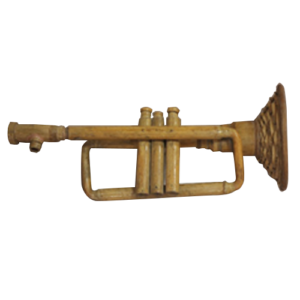Highschool Module
BAMBOO MUSICAL INSTRUMENTS OF T’BOLI IN SOUTH COTABATO
Background
No content.
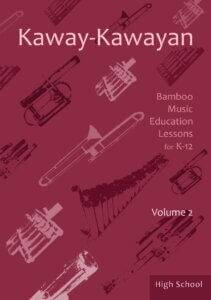
No content.
No content.
No content.
No content.
No content.
Excerpt from the BMI Ethnography of T’boli of Lake Sebu, South Cotabato
“The Bamboo Musical Instruments of the T’boli of Lake Sebu” By Juliet R. Bien
This ethnography is about the bamboo instruments of the T’boli of Lake Sebu. The name “T’boli” is a combination of tau, meaning “people,” and bilil or “hill” or “slope,” thus meaning “people living in the hills.” The other terms that refer to the T’boli are Tboli, Tiboli, and Tagabili. They are an indigenous people living in the southern part of Mindanao, particularly in the municipalities of T’boli Surallah, Lake Sebu, and Polomolok in the province of South Cotabato and in Maasim, Kiamba, and Maitum in Sarangani. The municipality of Lake Sebu has 19 barangays, and the T’bolis live with the Ubos, the Manobos, and the Tasadays.
Lake Sebu as the T’boli’s cultural heartland refers to two geographical areas: the municipality, and the lake within. Both are located in the Allah Valley, bounded on the north by the municipality of Surallah, in the southwest by the municipalities of Maitum and Kiamba, on the east by the municipality of T’boli and on the west by the municipality of Palembang in the province of Sultan Kudarat.
Musical instruments among the T’boli are classified as male and female. Megel/ lembang are male and lemnoy/lemnek are female. Male instruments are loud and played in public while female instruments are soft and are played in private. Citing Manolete Mora, an ethnomusicologist whose expertise is T’boli music, Jimenez says that these categorizations are very fluid as it “does not directly and exclusively determine the social situations in which the instruments are played. Rather, it identifies instruments within a general orientation and this type of categorization is not immutable.” Among the bamboo instruments discussed in this documentation, the sacred drum t’nonggong is male and the rest are female.
The bamboo instruments featured in this ethnography are played for personal and community entertainment. Music-making is usually conducted at home for domestic enjoyment, to rest after a day’s work. Community celebrations such as weddings and settlements of conflict among the T’boli also require music performance and dancing. Music festivals also provide occasions for a big gathering of musicians in the community. The Halabon festival which occurs every November is an example of a big festival participated in by the musicians of the community. The cultural masters and instrument-makers interviewed for this research are the resource persons who teach the younger members of their community. Regular visitors, tourists, students, and music enthusiasts are the audiences who avail themselves of the traditional knowledge shared by the masters and instrument-makers.
The size of Philippine indigenous musical instruments mentioned in this research are not standardized. The instruments’ measurements are written in approximate units of lengths and diameters because they are handcrafted individually. The musical instruments vary in sizes because of the materials used, that are readily available in their environment.
The bamboo musical instruments of the T’boli are following:
|
Instrument |
Method of Sound Production |
Melodic Range |
Role in the Ensemble |
Function in Ritual or Social/ Cultural Activity | |
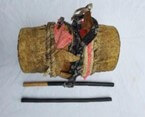 |
Kesal (slit drum, idiophone) |
laid horizontally, beaten with two wooden sticks |
A3 |
Individually played
Accompanies t’nonggong |
Personal entertainment
Festivals
Community celebrations |
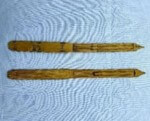 |
Kumbing (jaw’s harp, idiophone) |
plucked |
Kumbing1 C3-F#3
Kumbing 2 C#3-A3 |
individually played |
Personal entertainment
Festivals
Community celebrations |
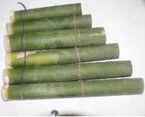 |
Klintang sokong, (idiophone) |
Beaten with sticks on the open-ended upper tube |
A2-B2 |
Played by 2
Plays with the rest of the instruments in the klin- tang sokong ensemble |
Personal entertainment
Festivals
Community celebrations |
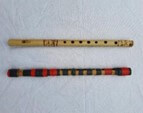 |
Sloli (chip on ledge flute, aerophone) |
blown |
Sloli 1: A3-D5
Sloli 2: C#3-B5 |
individually played |
Personal entertainment
Festivals
Community celebrations |
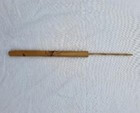 |
Few onuk (flute imitating bird sounds, aerophone) |
blown |
A7#-B7 |
individually played |
Personal entertainment
Festivals
Community celebrations |
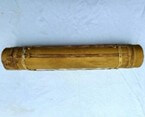 |
Sludoy (5-stringed
tube zither, cordophone) |
plucked |
D3-A3 |
Individually played |
Personal entertainment
Festivals
Community celebrations |
End Notes
- “T’boli” CCP Encyclopedia of Philippine Art. Accessed May 2, 2022. https://epa.culturalcenter.gov.ph/1/2/2376/.
- Ibid.
- BMI interview with Boi Rosie Sula, March 31, 2022.
- Earl Clarence Jimenez, “The Life of a Drum: The T’nonggong of the T’boli of Lake Sebu, South Cotabatao, Philippines” MA Thesis (Manila: Philippine Women’s University, 2014), 11.
- Earl Clarence Jimenez, “The Life of a Drum: The T’nonggong of the T’boli of Lake Sebu, South Cotabatao, Philippines” MA Thesis (Manila: Philippine Women’s University, 2014), 30.
- Manolete Mora, “Lutes, Gongs, Women and Men: (En)Gendering Instrumental Music in the Philippines.” Ethnomusicology Forum, 227.
- Ibid., 32.
OBJECTIVES
A. Content Standards
Demonstrate understanding of the music of the T’boli ethnolinguistic group and analyze the music through performances, listening, musical mapping, and improvisation, and giving importance to the relevance of music in the culture.
B. Performance Standards
- Perform examples of music from the T’boli, alone and with others, with appropriate tone, rhythm, and style.
- Explore other functions of music through improvisation, dance, and instrument playing.
C. Learning Competencies/Objectives
- Analyze the musical elements of bamboo music from the T’boli ethnolinguistic group.
- Explain the distinguishing characteristics of the music of the T’boli in relation to the culture and history of the surrounding area.
- Analyze the functions and significance of bamboo music to the lives of the T’boli community.
- Perform various T’boli tunes and patterns using bamboo musical instruments or improvised instruments.
- Improvise simple melodic and rhythmic patterns to accompany the music of the T’boli ethnolinguistic group.
CONTENT
A. Bamboo music of the T’boli ethnolinguistic group
B. Musical elements present in T’boli bamboo music
C. Social functions of music Music for entertainment, work, rituals, and celebrations
D. Significance of music to the culture Functional music, ritual music, dances, and songs
E. Performance styles and techniques of T’boli bamboo music
LEARNING RESOURCES
A. References
1. Print Materials
- BMI ethnography on Bagobo-Tagabawa in Davao
- BMI documentation pictures of the Bagobo-Tagabawa people and bamboo instruments
- The T’boli by Lourdes C. Manzano: https://ncca.gov.ph/about-ncca-3/subcommissions/subcommission-on-cultural-communities-and-traditional-arts-sccta/central-cultural-communities/the-tboli/
- Peoples of the Philippines: T’Boli: https://ncca.gov.ph/about-culture-and-arts/culture-profile/glimpses-peoples-of-the-philippines/tboli/
2. Audio-Video Materials
- Videos from the BMI documentation
- Video of the T’boli tribe
- Video of the T’boli, South Cotabato, Philippines
- Video of the T’boli music instruments
- Video of Champion Sta. Cruz Mission School, Inc. – T’nalak Festival 2015
B. Other Learning Materials
Improvised percussion instruments:
- Available bamboo musical instruments from the T’boli ethnolinguistic group
- Improvised slit drum (cylindrical can, container, or PVC pipe with a slit in the middle)
- Improvised klintang sokong (6–8 cylindrical cans, containers, or PVC pipes; graduated in size with 2-inch difference; tied together in a row by a string)
- Double-headed drum (large tin can or cylindrical container with layers of packing tape for the membrane/skin)
- Sticks for playing the percussion instruments (drumsticks or long wooden/ bamboo sticks)
PROCEDURE
A. Reviewing the previous lesson or presenting the new lesson
- Play the video the T’boli tribe.
- Ask the students the part of the video that caught their attention or made them want to learn more about the T’boli tribe.
- Tell the students that knowing and learning about the music of the T’boli means we should at least be familiar with the other aspects of their culture such as geographical location, dances, religious beliefs, rituals, food, and way of life. All of these aspects are connected to each other like a web, which gives a clear understanding of the culture of a particular ethnolinguistic group. While looking at photos of ethnolinguistic groups could give us an idea about them, it is important to know all other aspects of their culture.
B. Establishing the purpose of the lesson
- Play the video T’boli, South Cotabato, Philippines, taking note of the different instruments and music that was featured in the video.
- Divide the class into groups of 4–5 students. Ask the students to describe the indigenous music of the T’boli and how they think the other aspects of their culture affect the way they make music and musical instruments. Specifically, ask how bamboo plays a big part in the T’boli community. Guide questions may be provided for group discussions.
- Let each group report their answers to the class.
- Emphasize that the T’boli tribe is doing their best to preserve their culture and make it sustainable by using the same materials that they’ve been using for a long time. Most of their instruments are made of bamboo, a grass which commonly grows in their surroundings. They also plant bamboo in their farms so that they do not need to go to the mountains to harvest bamboo.
C. Presenting examples/instances of the new lesson
- Watch a T’boli BMI video of T’boli masters playing their bamboo instruments while dancing (hegelung and t’nonggong with kesal).
- Ask the students to describe the rhythmic and melodic patterns they heard. Let them explain how the music effectively accompanied the dancer.
- Let the students know that the T’boli tribe have music that can be performed alone or in a group.
D. Discussing new concepts and practicing new skills no. 1
- Discussion on the previous videos watched:
- The T’boli ethnolinguistic group calls South Cotabato their home, with most of them living in the towns of Kiamba, Polomolok, and Surallah. One of their most famous lakes is Lake Sebu. They only opened their doors for tourists last 2014, with the permission of the royal family. They are also known for their t’nalak, their sacred traditional cloth woven from the tie-dyed abaca fiber. They belong to the lumad or non-Muslim indigenous peoples of Mindanao.
- Their music involves singing and playing their indigenous instruments. Music is also used to accompany dances, rituals, and work. Their music instruments have specific functions. It can be used during rituals. Likewise, their music instruments can also be used for courtship and for entertainment during special occasions.
- The T’boli have a variety of bamboo musical instruments (tubes, drums, flute, zither, and jaw’s harp) which makes melodic and rhythmic patterns that may be played on its own or in a group. It may also be used to accompany a song or dance. Play the T’boli BMI videos of T’boli masters playing their instruments and the video T’boli music instruments.
- Divide the class into groups and let each group create their own sokong, t’nonggong, and kesal using improvised materials such as cylindrical cans, containers, PVC pipes, or whatever material is available to them. These instruments will be used for their performance-based assessment. Show the students the BMI T’boli pictures of the instruments.
E. Discussing new concepts and practicing new skills no. 2
- Watch an excerpt of the video Champion Sta. Cruz Mission School, Inc. – T’nalak Festival 2015.
- Give a brief background on the T’nalak Festival. Held in the month of July, this festival is an ode to the famous indigenous textile of the T’boli. T’nalak weavers often dream of the design they create. T’nalak weaving patterns require a lot of perseverance to form. The women of the community weave the cloth together. The festival showcases the creativity, unity, and resilience of the T’boli tribe.
- Group Performance:
- Guide the students in listening to the video recordings and playing an instrument by ear.
- Let each group decide on what social function (celebratory dance, leisure, entertainment) they would like their music to be used for.
- Let them improvise rhythmic and melodic patterns on their improvised bamboo instruments.
F. Developing mastery (leads to formative assessment)
- Let the groups assign each member to play an instrument. The klintang sokong may have 2–3 players.
- Give them 2–3 sessions to create and practice their improvised rhythmic and melodic patterns for a 1 to 2-minute performance.
- Let each group perform in front of the class.
- Assess the performance using teacher-made rubrics.
G. Finding practical applications of concept and skills in daily living
The music of the T’boli tribe is related to their relationship with deities, with each other, and with their surroundings. How does your way of living affect the kind of music that you listen to and perform? How does the music you listen to and perform affect your way of life?
H. Making generalization and abstraction about the lesson
Philippine indigenous music, such as that of the T’boli tribe, is proof that our ethnolinguistic groups are civilized. Even before the colonizers came, our ethnolinguistic groups already had their own set of beliefs, cultures, and practices as a community. They were able to preserve and sustain their culture until today. Music is an important aspect of one’s identity as an individual and as a community.
On the other hand, modernization poses a threat to the preservation of their indigenous music and culture. Due to modernization and technology that are more appealing to the younger generation, there are indigenous practices like tattooing and weaving that are slowly disappearing. Can modernization be used to preserve our indigenous music and culture?
I. Additional activities for application or remediation
Students who are good with dancing and body movements may incorporate dance into their group performance or even dance while playing an instrument. Other students may provide creative visual aspects to their performance such as designing the music instruments and props.
Students may read more about the T’boli tribe so that their perspective on T’boli bamboo instruments is more informed. An output may also be produced in partnership with other subjects such as PE (indigenous dance) or Social Studies.
REFLECTION
1. How many learners earned 80 percent in the evaluation? How many learners require additional activities for remediation?
2. Did the remedial lesson work? How many learners have caught up with the lesson? How many learners continue to require remediation?
3. Which of my teaching strategies worked well? Why did this work?
4. What difficulties can my principal or head teacher help me solve?
5. What innovation or localized materials did I use/discover which I wish to share with other teachers?
Science in a creative industry.
The DOST-FPRDI has a Bamboo Musical Instruments Innovation R&D program aimed at improving the quality of locally-made bamboo musical instruments (BMIs) through science and innovative technologies. The program seeks to standardize the production of selected BMIs, develop prototype designs, analyze raw material sources and existing markets, and build a BMI processing facility. In addition, the program aims to document the ethnocultural story behind several BMIs and identify the bamboo species used in BMI production to promote public awareness and appreciation of the cultural importance of these musical instruments. The program is a collaboration with the University of the Philippines and Philippine Normal University for teaching modules and analyzing sound quality and standardization of BMI design. The DOST Grants-in-Aid program provides funding.
PhBMI

